
The Dress Diary by Dr. Kate Strasdin
Some mornings, it’s a bigger decision than others. Button-down or tee? Jeans or stretchy pants? Dress for success or comfort? The answer changes every day and you have options. Your closet is calling and so are these two books about fashion and clothing.
Imagine being gifted a mysterious treasure so intriguing that it almost consumes you, but so delicate that the wrong kind of touch could take it away. That’s what happens in The Dress Diary by Dr. Kate Strasdin, a fashion historian and museum curator.
In early 2016, an “elderly lady” gave Strasdin a package that contained a book, but not just an ordinary volume. It was a diary of sorts, in which a young woman had kept extensive notes on the clothing she wore; when she married, she kept record of her husband’s outfits, too. Pasted with her notes were small scraps of fabric and lace saved from the bolts of cloth used to make each dress. The book began in 1838.
Who was the upper-class, educated lady who so carefully saved details of the contents of her wardrobe, and why did this wonderful relic matter? Fashionistas, clothes horses and readers who love style will want to find out. This genteel book is also an excellent read for lovers of British history or Victoriana.
“Dr. Strasdin’s new study is a swatch and memories book from a Victorian lady named Ann Sykes,” writes Sarah Morgan in The Costume Society blog. “The book came into Dr. Strasdin’s collection by a matter of happenstance, being handed off between individuals until it was given to Dr. Strasdin. Each page records the individual personality and taste of the writer, the previously unrecognized Mrs. Sykes, and her friends. As Dr. Strasdin defines it, macro and microhistory are combined into one object, helping to outline and define often underrepresented women who would have been defined by their husbands.”
As Strasdin researched, she learned that Mrs. Sykes was the daughter of a mill owner in Lancashire, England. She married a textile merchant and lived in Singapore for a time. “As a woman steeped in the textile trade of Victorian England, Mrs. Sykes was uniquely placed to reflect upon and share the costume of the period,” Morgan continues. “From one detail of a wedding came a marriage certificate, then a genealogy, and a series of investigations that uncovered a story of individuals through objects. Scraps of fabric and written details in a marbled accounts book reveal a woman and her circle of friends and acquaintances. It is a snapshot of a period and a place through the eyes of an individual, despite being in third person, and their collected scraps. However, without the legwork of research and the availability of sources, there would be no book.” Fragments of cloth are a view into Victorian life, including the use of poisonous dyes and the human cost of Britain’s cotton industry.
As a bonus, here’s To Dye For: How Toxic Fashion is Making Us Sick – And How We Can Fight Back by Alden Wicker.
Every day when you get dressed, you want your outfit to look sick, as they say. You don’t want it to make you sick, but that may be what’s happening. Chances are, you’ve indulged in a fun bit of “fast fashion” recently; you know, those cheap, quick, wear-it-twice garments that go in and out of vogue seemingly within an hour. You probably know that those items are controversial: the labor practices are questionable, and those things are pretty wasteful. But Wicker says that the problems with fast fashion don’t stop at the factory that makes the items.
Cheaply made clothing, she says, may also be harming your health. The synthetic dyes in those shirts, pants and dresses aren’t regulated and they’re not safe; in fact, those dyes could be at the root of some of our most bothersome (at best) and most deadly (at worst) modern maladies.
So, what can you do? In this book, Wicker offers advice for knowing what you’re putting on your body, and how to maintain the favorite outfits that are safe. She offers ways to clean up your closet. And she advises readers to be the voice of change, making this a great book for anyone who cares what they wear.
So, your closet needs more clothes and your bookcase, more books? Then head for your favorite library or bookstore and ask for help finding some great surprises in clothing history, style, manufacture, modeling and how-to. Booksellers and librarians know where all the best books and magazines on fashion and clothing are kept, and they’ll be happy to help you find what you need to be the best dressed reader around. What a great decision!




